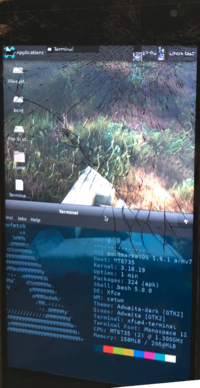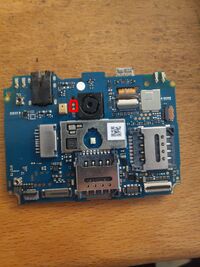Wiko U FEEL (wiko-ufeel): Difference between revisions
UnDevDeCatOS (talk | contribs) mNo edit summary |
m Add type |
||
| (28 intermediate revisions by 8 users not shown) | |||
| Line 4: | Line 4: | ||
| codename = wiko-ufeel | | codename = wiko-ufeel | ||
| image = File:wiko-ufeel.png | | image = File:wiko-ufeel.png | ||
| imagecaption = Picture of XFCE4 running on Wiko U FEEL with downstream kernel | | imagecaption = Picture of XFCE4 running on Wiko U FEEL (p6609) with downstream kernel | ||
| releaseyear = 2016 | | releaseyear = 2016 | ||
| originalsoftware = Android 6 | | originalsoftware = Android | ||
| originalversion = 6 (Linux 3.18.19+) (32-bit mode) | |||
| pmoskernel = 3.18.19 | |||
| chipset = MediaTek MT6735 | | chipset = MediaTek MT6735 | ||
| cpu = 1.3 GHz | | cpu = 4x 1.3 GHz Cortex-A53 | ||
| gpu = | | gpu = Mali T-720 | ||
| storage = 16GB eMMC | | storage = 16GB eMMC | ||
| display = 720x1280 LCD | | display = 720x1280 LCD | ||
| memory = 3072 MiB | | memory = 3072 MiB | ||
| architecture = armv7 | | architecture = armv7 | ||
| type = handset | |||
<!-- the following status_* questions should be answered with Y - yes, P - partial, N - no, or left blank (for untested or unknown) --> | <!-- the following status_* questions should be answered with Y - yes, P - partial, N - no, or left blank (for untested or unknown) --> | ||
| status_usbnet = Y | | status_usbnet = Y | ||
| Line 27: | Line 30: | ||
| status_accel = | | status_accel = | ||
| status_audio = P | | status_audio = P | ||
| status_bluetooth = | | status_bluetooth = N | ||
| status_camera = | | status_camera = N | ||
| status_gps = | | status_gps = | ||
| status_mobiledata = | | status_mobiledata = N | ||
| status_sms = | | status_sms = N | ||
| status_calls = | | status_calls = N | ||
| status_fossbootloader = N | |||
| status_uboot = | |||
| status_uboot_primary = | |||
| status_uboot_secondary = | |||
| status_uboot_mainline = | |||
| status_uboot_internalstorage = | |||
| status_uboot_sd = | |||
| status_uboot_usbhost = | |||
| status_uboot_usbperipheral = | |||
| status_uboot_screen = | |||
| status_uboot_keyboard = - | |||
| status_uboot_buttons = | |||
| status = | | status = | ||
| booting = yes | | booting = yes | ||
<!-- you can also use these lines if you need to: | <!-- you can also use these lines if you need to: | ||
see Unixbench page on wiki | see Unixbench page on wiki | ||
| whet_dhry = 0.0 | | whet_dhry = 0.0 | ||
| Line 46: | Line 57: | ||
| status_otg = - | | status_otg = - | ||
--> | --> | ||
}} | }}{{Based on SoC|MediaTek_MT6735|MediaTek MT6735}} | ||
== Architecture == | |||
{{note|'''Note:''' Even though MT6735 is capable of aarch64, some variants ship with a broken lk bootloader, a broken ARM Trusted Firmware implementation and/or a downstream kernel that compiles only on armv7. Therefore, this device can only boot on armv7 at the moment. Work is being done to replace the stock bootloader with u-boot.}} | |||
== Contributors == | == Contributors == | ||
| Line 57: | Line 71: | ||
== Users owning this device == | == Users owning this device == | ||
{{Device owners}} | {{Device owners}} | ||
== Board == | == Board == | ||
Wiko U Feel | Wiko U Feel has two different board revisions: one using the Tinno p6601 board (like BLU R1 HD, Lanix Ilium L910, QMobile Noir A6, Evertek EverSolo, Smart Art P6601) and the other using the p6609 board. It appears that the current packaged kernel is compatible between these two boards. | ||
=== UART (p6609) === | |||
1.8V UART pins are exposed on the motherboard. Removing the back cover and unscrewing a plastic frame gives you access to them. According to the board, the RX pin is at the top and the TX pin at the bottom. Baud rate is 921500 for preloader/lk, and 112500 for BootROM. | |||
[[File:UFEEL-P6609-UART.jpg|200px]] | |||
== WiFi == | == WiFi == | ||
| Line 87: | Line 102: | ||
* [https://www.gsmarena.com/wiko_ufeel-9030.php Full phone specifications] | * [https://www.gsmarena.com/wiko_ufeel-9030.php Full phone specifications] | ||
* [http://www.wikogeek.com/index.php?telephone=U+FEEL Official Kernel source] | * [http://www.wikogeek.com/index.php?telephone=U+FEEL Official Kernel source] | ||
* [https://drive.google.com/file/d/13PncvB_jy6oPZvHO4FWl-bkcSCqlTSF6/view TWRP Image] | * [https://drive.google.com/file/d/13PncvB_jy6oPZvHO4FWl-bkcSCqlTSF6/view Unofficial TWRP Image] | ||
* {{MR|573|pmaports}} Initial merge request | * {{MR|573|pmaports}} Initial merge request | ||
* {{Device package|wiko-ufeel}} | |||
* {{Kernel package|wiko-ufeel}} | |||
[[Category:Devices with known UART pinout]] | |||
Latest revision as of 18:09, 12 September 2024
 Picture of XFCE4 running on Wiko U FEEL (p6609) with downstream kernel | |
| Manufacturer | Wiko |
|---|---|
| Name | U FEEL |
| Codename | wiko-ufeel |
| Released | 2016 |
| Type | handset |
| Hardware | |
| Chipset | MediaTek MT6735 |
| CPU | 4x 1.3 GHz Cortex-A53 |
| GPU | Mali T-720 |
| Display | 720x1280 LCD |
| Storage | 16GB eMMC |
| Memory | 3072 MiB |
| Architecture | armv7 |
| Software | |
| Original software | Android |
| Original version | 6 (Linux 3.18.19+) (32-bit mode) |
| FOSS bootloader | no |
| postmarketOS | |
| Category | testing |
| Pre-built images | no |
| postmarketOS kernel | 3.18.19 |
| Flashing |
Partial |
|---|---|
| USB Networking |
Works |
| Internal storage |
No data |
| SD card |
No data |
| Battery |
No data |
| Screen |
Works |
| Touchscreen |
Works |
| Multimedia | |
| 3D Acceleration |
No data |
| Audio |
Partial |
| Camera |
Broken |
| Camera Flash |
No data |
| Connectivity | |
| WiFi |
Broken |
| Bluetooth |
Broken |
| GPS |
No data |
| NFC |
No data |
| Modem | |
| Calls |
Broken |
| SMS |
Broken |
| Mobile data |
Broken |
| Miscellaneous | |
| FDE |
Broken |
| USB OTG |
No data |
| HDMI/DP |
No data |
| Sensors | |
| Accelerometer |
No data |
| Magnetometer |
No data |
| Ambient Light |
No data |
| Proximity |
No data |
| Hall Effect |
No data |
| Haptics |
No data |
| Barometer |
No data |
| This device is based on the MediaTek MT6735. See the SoC page for common tips, guides and troubleshooting steps |
Architecture
| Note: Even though MT6735 is capable of aarch64, some variants ship with a broken lk bootloader, a broken ARM Trusted Firmware implementation and/or a downstream kernel that compiles only on armv7. Therefore, this device can only boot on armv7 at the moment. Work is being done to replace the stock bootloader with u-boot. |
Contributors
- UnDevDeCatOS
- cerdini
Maintainer(s)
- UnDevDeCatOS
Users owning this device
- UnDevDeCatOS (Notes: 2 of them, working on mainline!!!!!!!)
Board
Wiko U Feel has two different board revisions: one using the Tinno p6601 board (like BLU R1 HD, Lanix Ilium L910, QMobile Noir A6, Evertek EverSolo, Smart Art P6601) and the other using the p6609 board. It appears that the current packaged kernel is compatible between these two boards.
UART (p6609)
1.8V UART pins are exposed on the motherboard. Removing the back cover and unscrewing a plastic frame gives you access to them. According to the board, the RX pin is at the top and the TX pin at the bottom. Baud rate is 921500 for preloader/lk, and 112500 for BootROM.
WiFi
As described in the WiFi troubleshooting guide, you need a firmware loader, named 6620_launcher, but it panics the kernel. If you want to debug wifi, then check out the mediatek section on the WiFi page.
Audio
Sound card is detected in alsamixer, but dosen't work
Device Tree
I couldn't find the official dtsi source code, so i decompiled the dtb blob from the stock rom with dtc command line tool. Unfortunately with this method we don't have the comments.
How to enter flash mode
Fastboot is broken. It gives Unknown Chunk type, but it is possible to install pmOS with TWRP. Refer to Android_Recovery_Zip_Installation for installing.
Flashing with proprietary program SP Flash Tool also work fine. Tested with flashed emmc boot partition and system partition stored on external sdcard.
Installation
Links
- Full phone specifications
- Official Kernel source
- Unofficial TWRP Image
- pmaports!573 Initial merge request
- Device package
- Kernel package
